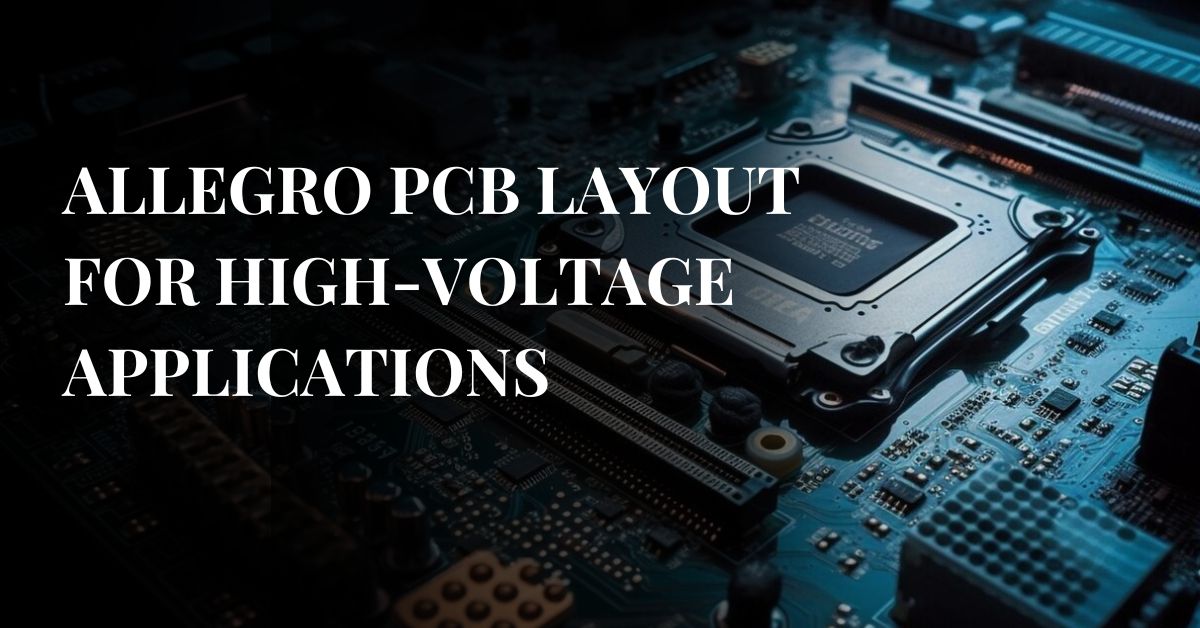Designing printed circuit boards (PCBs) for high-voltage applications involves unique challenges that require specialized knowledge and careful planning. High-voltage circuits are used in various industries, including power electronics, automotive, aerospace, and industrial automation. Allegro PCB design software, developed by Cadence, provides powerful tools and features that facilitate the creation of reliable and efficient high-voltage PCB layouts. This article explores key considerations, best practices, and techniques for designing high-voltage PCBs using Allegro PCB software.
Understanding High-Voltage Applications
High-voltage applications typically involve operating voltages that exceed the standard levels found in typical electronic devices. These applications can range from a few hundred volts to several kilovolts. The primary challenges in high-voltage PCB design include managing electrical clearance, controlling electromagnetic interference (EMI), ensuring safety, and maintaining the integrity of the circuit under high stress.
Key Considerations for High-Voltage PCB Design
-
Electrical Clearance and Creepage: Electrical clearance refers to the minimum distance between conductive elements through the air, while creepage distance is the minimum path between conductive parts along the surface of the insulating material. Both are critical in preventing electrical arcing and ensuring the safety and reliability of the high-voltage PCB.
-
Insulation and Dielectric Materials: Using appropriate insulation and dielectric materials is crucial for high-voltage applications. Materials must withstand high electric fields without breaking down. Common materials include FR-4 for standard applications and specialized high-voltage materials like PTFE or ceramic-based substrates for more demanding environments.
-
Trace Width and Spacing: Wider traces and increased spacing between traces help reduce the risk of arcing and improve the board’s ability to handle high currents. Allegro PCB allows designers to specify trace width and spacing rules based on the voltage levels and current requirements.
-
Thermal Management: High-voltage circuits often generate significant heat, requiring effective thermal management to prevent component damage and ensure reliable operation. This involves using thermal vias, heat sinks, and proper component placement to dissipate heat efficiently.
-
Shielding and Grounding: Proper shielding and grounding techniques are essential to minimize EMI and ensure stable operation. Allegro PCB provides tools for implementing ground planes, shielding traces, and designing effective grounding schemes.
Best Practices for High-Voltage PCB Design in Allegro
-
Define Design Rules: Start by defining the design rules specific to high-voltage applications in Allegro PCB. This includes setting clearance and creepage distances, trace width, and spacing rules. Allegro’s Constraint Manager allows you to enforce these rules throughout the design process, ensuring compliance with high-voltage requirements.
-
Layer Stackup: Design an appropriate layer stackup that supports high-voltage isolation. Use multiple ground planes and power planes to improve EMI performance and provide robust return paths for high-frequency signals. Ensure that high-voltage traces are adequately separated from low-voltage traces by using dedicated layers or keep-out zones.
-
Component Placement: Place high-voltage components strategically to minimize the risk of arcing and reduce noise coupling. Keep sensitive components, such as low-voltage control circuits, away from high-voltage areas. Use isolation barriers and clearances to separate high-voltage and low-voltage sections of the PCB.
-
Routing Techniques: Use wide traces for high-current paths and ensure sufficient spacing between high-voltage traces to prevent arcing. Avoid sharp corners in trace routing, as they can create points of high electric field concentration. Instead, use rounded corners or 45-degree angles for smoother current flow.
-
Via Design: Utilize multiple vias to connect high-current traces between layers, distributing the current load and reducing the risk of via failure. Consider using filled or plated-over vias for better thermal and electrical performance.
-
Thermal Vias and Heat Sinks: Incorporate thermal vias under power components to transfer heat to the opposite side of the board, where heat sinks or copper pours can dissipate it. Allegro’s thermal analysis tools help optimize the placement and size of thermal vias.
-
Ground Plane Segmentation: Segment ground planes to separate high-voltage and low-voltage grounds. Use a star grounding approach to minimize ground loops and improve EMI performance. Allegro PCB allows you to create separate ground nets and define their connections precisely.
-
Shielding: Implement shielding techniques to protect sensitive circuits from EMI. Use copper pours or dedicated shielding layers to cover high-voltage traces. Connect shields to ground at multiple points to ensure effective EMI suppression.
Advanced Techniques in Allegro PCB
-
Design Rule Checks (DRC): Utilize Allegro’s advanced DRC capabilities to validate your design against high-voltage requirements. Run DRC checks to identify potential clearance and creepage violations, incorrect trace widths, and other issues that could compromise the PCB’s performance.
-
Simulation and Analysis: Perform signal integrity and thermal simulations using Allegro’s integrated tools. These simulations help identify potential EMI issues, voltage drop concerns, and thermal hotspots. Use the simulation results to refine your design and ensure robust performance under high-voltage conditions.
-
3D Visualization: Allegro PCB’s 3D visualization features allow you to inspect the layout from different angles, ensuring proper clearance and spacing. This is particularly useful for verifying the physical separation of high-voltage and low-voltage areas and for visualizing complex multi-layer stackups.
-
Compliance with Standards: Ensure your design complies with relevant industry standards and regulations for high-voltage applications. Standards such as IPC-2221B for general PCB design and IEC 60950-1 for safety in electrical equipment provide guidelines for clearance, creepage, and other critical parameters.
Conclusion
Designing PCBs for high-voltage applications presents unique challenges that require careful consideration of electrical clearance, insulation, thermal management, and EMI control. Allegro PCB design software offers powerful tools and features that help engineers create reliable and efficient high-voltage PCB layouts. By following best practices, utilizing advanced techniques, and leveraging Allegro’s capabilities, designers can ensure their high-voltage PCBs meet stringent performance, safety, and regulatory requirements. Whether you’re working on power electronics, automotive systems, or industrial machinery, Allegro PCB provides the flexibility and precision needed to tackle the complexities of high-voltage design. Additionally, professional PCB layout services can further enhance the design process, ensuring optimal performance and compliance with industry standards.




